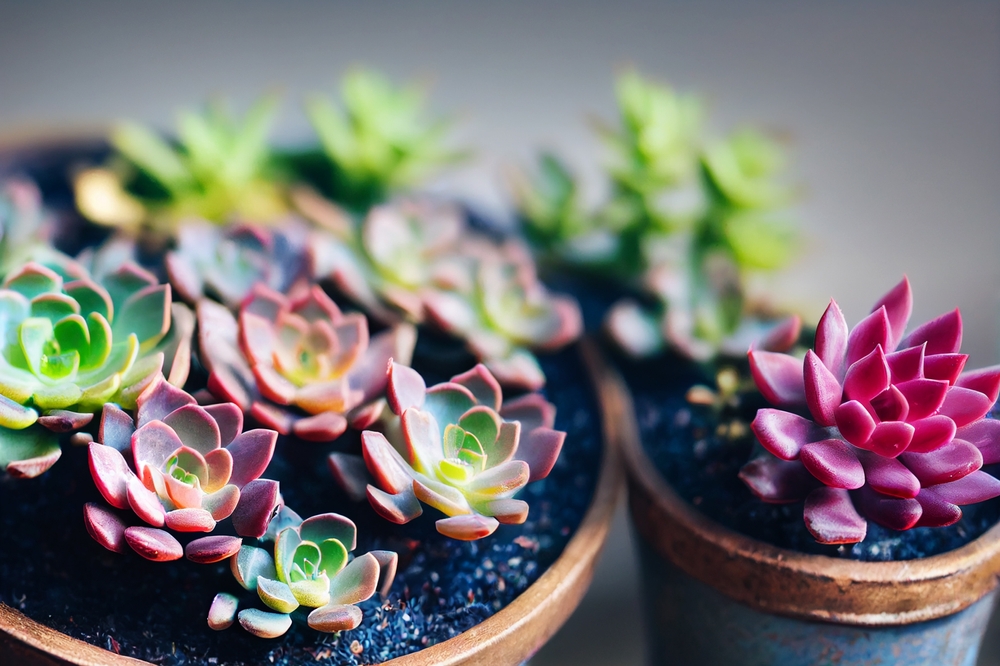
Pink succulents are gorgeous on their own or for some added color in arrangements. They’re charming additions to soft, pastel-colored rooms. They also make adorable gifts for Valentine’s Day, Mother’s Day, or for little gardeners who love pink.
Some gorgeous pink succulents include Pink Aeonium, Pink Lady, and Sand Rose. The best ones for your garden or apartment depend on how much water, humidity, and sunlight you can give them. Some of these plants require a lot of care, while others are less demanding.
In this article, I’ll list 22 of my favorite pink succulents. I’ll describe what they look like and how to care for them so you can decide which ones are right for your home.
1. Pink aeonium (Aeonium leucoblepharum)
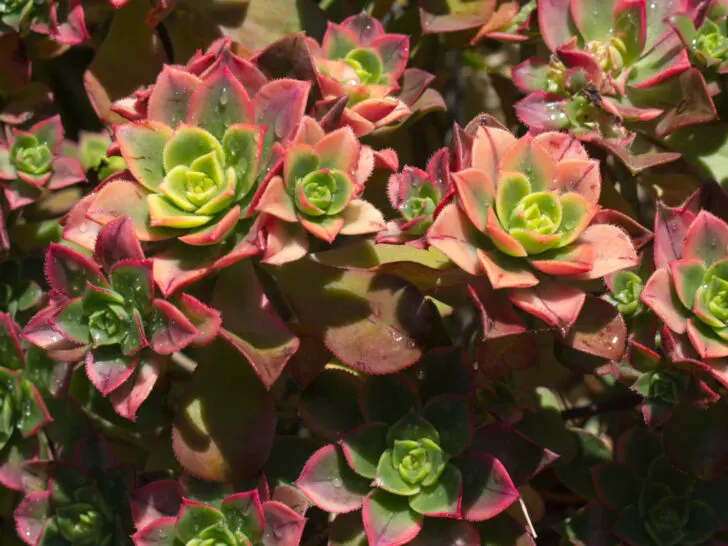
Pink aeoniums are a low-growing plant native to North Africa. They’re primarily dark green but will develop pink outlines around their leaves with proper care. They flower into rosettes with approximately seven to ten teardrop or spear-shaped leaves.
If you want your green aeonium leucoblepharum to develop its signature pink highlights, it needs a generous amount of sunlight and a modest amount of water.
Put your pink aeonium on the windowsill of a south-facing window for optimal sunlight. You only need to water it approximately once a week during dry seasons like fall or winter. If your home is humid, you can get away with only watering it once a month.
2. Sand Rose (Anacampseros rufescens)
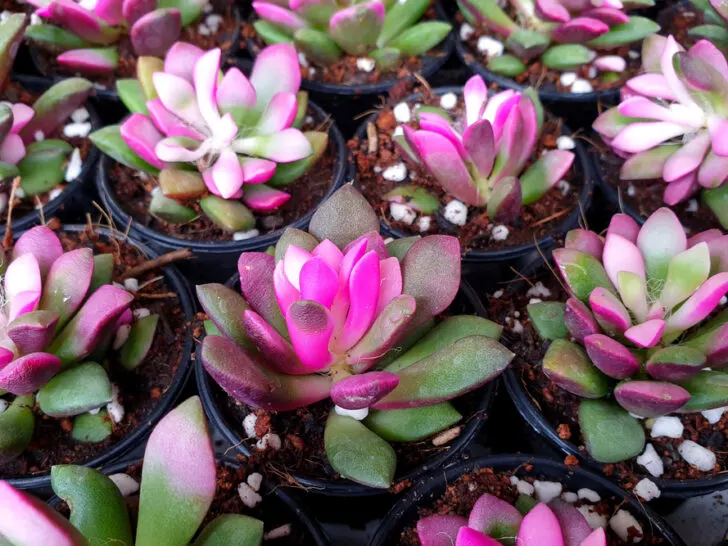
Anacampseros rufescens is also known as the ‘sand rose’ or ‘sunrise succulent.’ It’s a slow-growing South African plant with deep purplish-green leaves that will eventually turn bright pink. It’ll also grow light purple flowers at reproductive maturity.
This is not the right plant for you if you want a bright pink succulent immediately. You need to wait for your sand rose to turn pink. The time it takes an anacampseros rufescens to turn pink depends on sunlight exposure.
Give your sand rose about four to six hours of sunlight per day to encourage pink leaves. The more sunlight it gets, the more vivid its color becomes. However, be careful not to overdo it because this plant is prone to scorching.
It’s also important to note that this succulent hibernates during the winter. If your plant darkens during the colder season, that’s completely normal. During this time, it only needs water every two weeks due to low activity levels.
Sand roses are built for hot, dry environments. So, even during their active months, watering them once a week is sufficient.
3. Sunrise Succulent (Anacampseros telephiastrum variegata)

Like anacampseros rufescens, anacampseros telephiastrum variegata is also nicknamed the ‘sunrise succulent.’ These plants have teardrop-shaped leaves that are bright green at the base and fade into a light pink at the tips. Some leaves may be all green or all pink.
Despite their African origins, these plants don’t do well in direct sunlight. However, this makes them a great choice for apartments and offices that can only provide partial sunlight. They’re also fairly small, so they don’t need a large pot to thrive.
Give them a bright, warm room with partial sunlight and a low amount of water. Sunrise succulents can also be grown in outdoor planters since they have some frost tolerance. Remember, no succulent can stand the cold, so bring them inside if the temperature hits below 30°F (-1°C).
4. Pink Lady (Callisia repens)
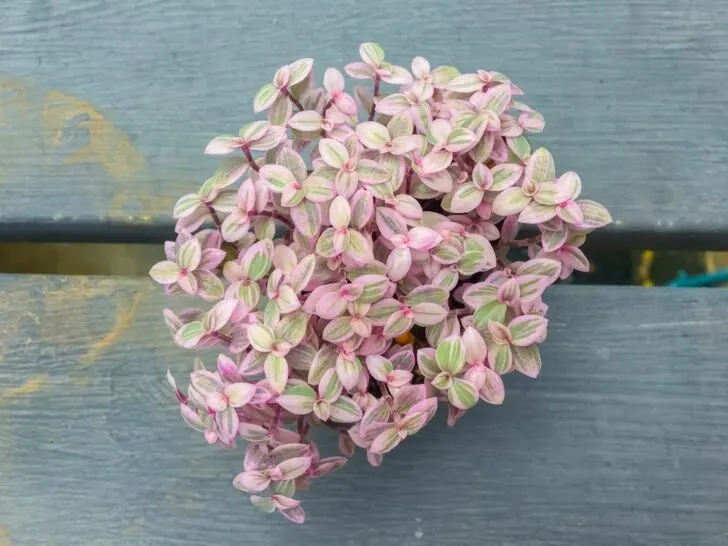
The callisia repens has many nicknames. It’s known as the ‘pink lady,’ ‘turtle vine,’ ‘pink panther,’ ‘creeping inchplant,’ or ‘pink bubbles.’ It has a bushy appearance with many tiny, waxy leaves that are soft green and creamy pink or lavender.
Pink ladies are beginner-friendly plants with an attractive appearance, which makes them a popular choice. They need a bright room with plenty of natural sunlight and partial shade. They only need to be watered every seven to ten days.
Indirect sunlight is better for these plants because they may scorch. Scorched leaves will have small dark spots. If your plant is scorched, remove it from direct sunlight to let it heal.
This plant earned the nickname ‘creeping inchplant’ because it grows into dangling vines with proper cultivation. You can prune your pink lady to keep it more compact or let it grow into creeping vines, depending on your preference.
5. Calico Kitten Crassula (Crassula pellucida)
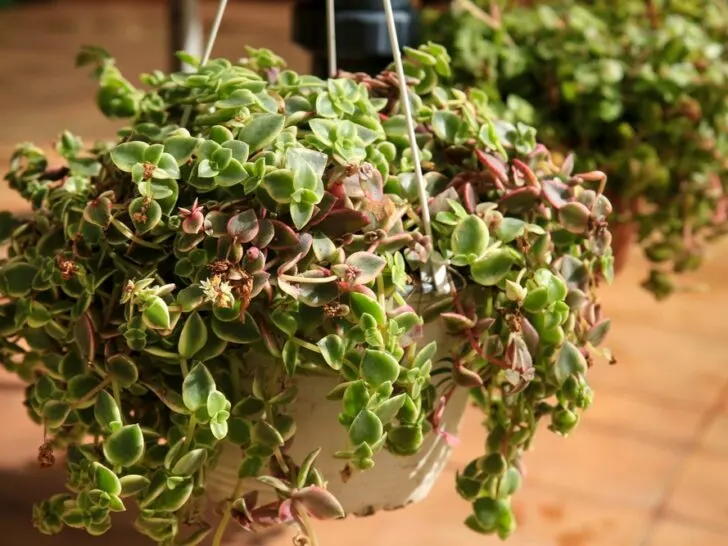
Crassula pellucida, also known as the ‘calico kitten plant,’ is a bushy succulent with small teardrop or heart-shaped leaves. Each leaf is green or purple in the center and has a reddish-pink outline. Some plants have a ‘calico’ look with green and purple leaves.
Calico kittens are slow-growing, so it will take some time before they fully blossom. I wouldn’t call them difficult plants, but they aren’t the best choice for people with busier lives.
Like any succulent, they don’t need much water. However, they can be fussy about their sunlight needs. They will eventually need six hours of sunlight daily but must first become accustomed to sunlight.
To acclimatize your calico kitten, slowly introduce it to direct sunlight by placing it in partial shade or only giving it about four hours each day. The leaves will burn or stretch out if your plant gets too much sun too fast.
6. Echeveria afterglow
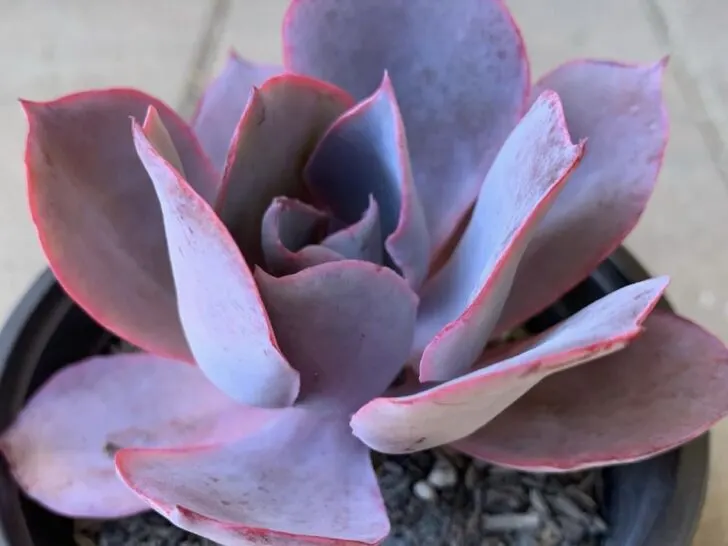
An echeveria afterglow grows into a large rose-shaped plant. They’re mint green, lavender, or bright bluish-purple with powder-pink edges. However, some plants have pure pink leaves. The large rose-like base may sprout a stem with flowers.
Afterglows can thrive in a wide range of lighting conditions, but they shouldn’t get more than four hours of direct sunlight daily. Even though these plants have low watering requirements, they’re prone to dehydration.
Dehydration occurs if the afterglow gets too much heat and sunshine. It likes the warmth but does better in a mild climate than in scorching heat.
During their active summer months, they collect water to store over winter. However, they cannot store enough water during dry, hot summers. This lack of stored water is what causes dehydration during the colder seasons.
7. Echeveria can can
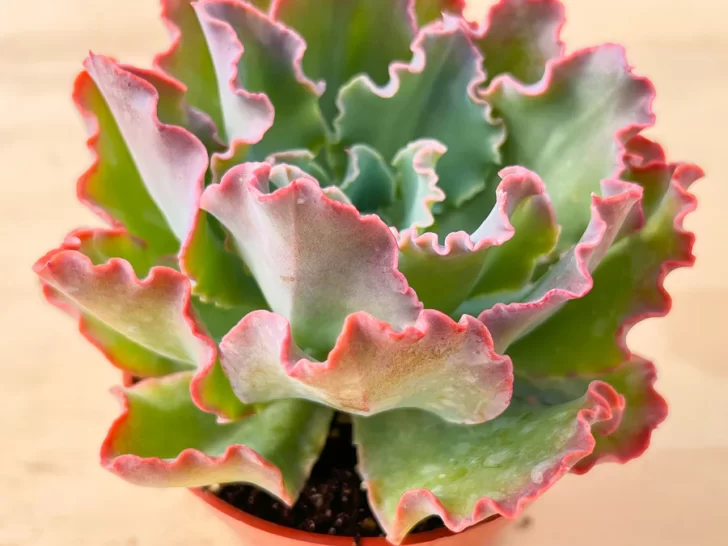
The Echeveria can can looks a bit like a cabbage or an underwater plant. It’s a large rosette with green leaves that have curly edges. Each curled edge is dusty pink in color. The pink color may bleed into the green creating an ombre effect or fully pink leaves.
Your Echeveria can can needs a lot of sunlight. Place it on an east or south-facing windowsill and give it at least six hours of sun a day. Additionally, this plant doesn’t like drastic changes in lighting. So, try your best to keep its sun times consistent.
Echeveria can cans will sometimes change color with age. If your pink and green plant suddenly turns brown and purple, it’s still healthy. Color changes are natural for this succulent. However, this might not be the best choice if you want a pink succulent that stays pink.
8. La Roseta (Echeveria laui)
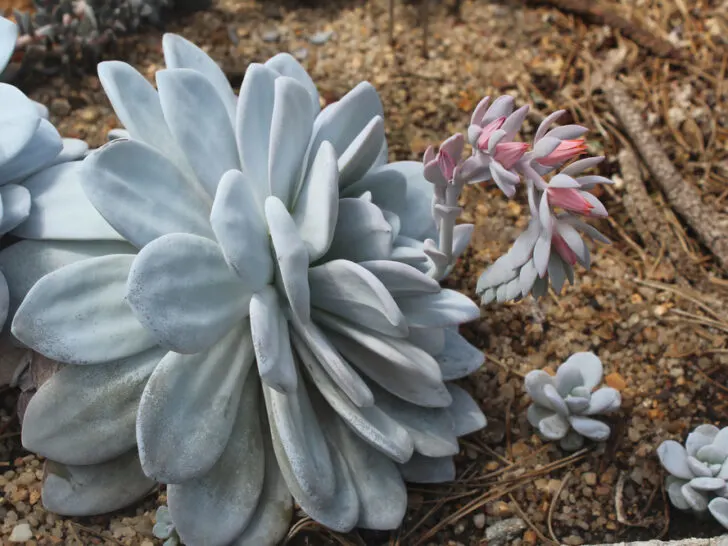
The Echeveria laui is a pale blue rose-shaped succulent with wide, rounded leaves. Lauis will turn powder pink when they’re under stress. However, unstressed blue lauis can still sprout pale pink or peach flowers.
Many sellers will sell lauis that they’ve already stressed to pink. The problem is that many buyers don’t know how to keep it under those conditions, so their plants turn back to blue.
Remember that its transformation from blue to pink is a stress response. So, you may or may not want to encourage your laui to turn pink. However, you can balance health and stress in a way that will let it thrive while pink.
One way to safely stress out your laui is to go for a long time without watering it. Succulents are drought-resistant but will get stressed if there is a significant lack of water. Let your laui’s soil completely dry out before you water it again.
If you think stressing it out is too much work, or you don’t like putting your plant under stress, blue lauis will still sprout pink flowers at reproductive maturity. Therefore, you can still get a pink succulent without stressing it out.
9. Hen and Chicks (Echeveria neon breaker)
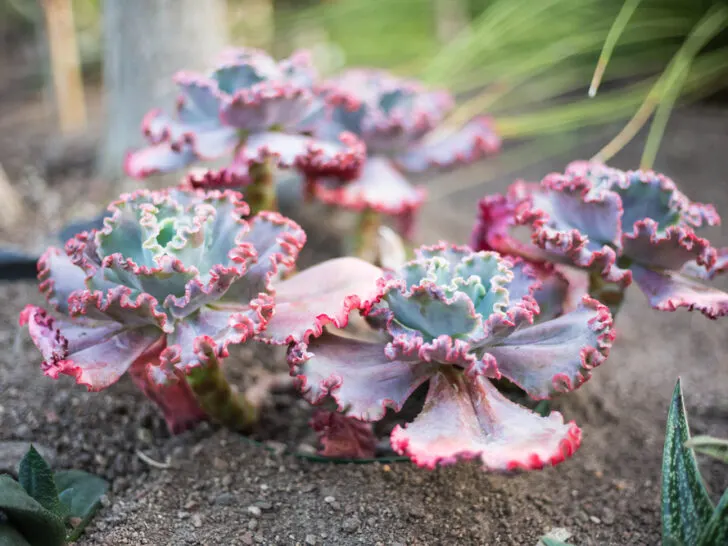
The echeveria neon breaker is a large rosette with long bluish-green or purple leaves. Each leaf has a pointed tip with ruffled pink edges. Its color will be soft at first, but as it grows, the greens, purples, and pinks in its leaves will become vivid, ‘neon’ shades.
Neon breaker care is fairly simple, making them good beginner-friendly succulents. The more sunlight they get, the more vivid they’ll be. So, give them at least six hours of sunshine per day.
Water them using the ‘soak and dry’ method. This method involves giving your neon breaker a lot of water per watering session, then waiting a long time before watering it again. Touch the soil to see if it’s dry before you ‘soak’ it again.
10. Mexican Peacocks (Echeveria peacockii)
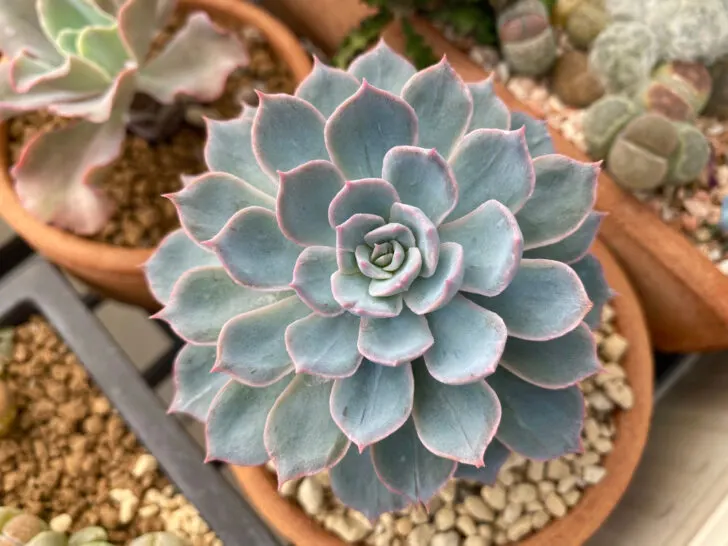
Echeveria peacockii, also known as the ‘Mexican peacock,’ is a silvery blue rose-shaped succulent with teardrop-shaped leaves and reddish-pink edges. These plants are quite small, making them ideal for desks and centerpieces.
Mexican peacocks are low-maintenance plants that can thrive in bright light or shade. It’s best to put these plants near an eastern or western-facing window to give them moderate sunlight. They also prefer the ‘soak and dry’ watering method.
At reproductive maturity, Mexican peacocks will produce orangey-red flowers every summer. The flowers will grow from a stem that sprouts from the middle of the base rosette.
11. Pearl of Nunberg (Echeveria perle von nurnberg)

The Perle von nurnberg, sometimes shortened to ‘PVN,’ is a German hybrid succulent. It’s rose-shaped and has bluish-purple leaves with a pink tint. Each heart-shaped leaf has a bright pink outline. New leaves start pink and slowly turn purple with age.
New leaves grow in the center of the rosette. As a result, these succulents have a stunning ombre coloration that’s pink in the middle, purple on the outside, and pink again at the tips. The PVN has a frosty look due to pruinose.
Pruinose (also known as farina) is a dusty white coating that covers each leaf. Its purpose is to protect the plant from intense sunlight and burns. Pruinose is also water-repellent, which prevents droplets from accumulating on leaves.
PVNs need approximately six hours of full sunlight per day. Their pruinose layer offers some protection from scorching, but it doesn’t make them scorch-proof. Signs of overexposure include discoloration, curling, and drying.
Like many echeverias, PVNs prefer the ‘soak and dry’ watering method. However, they become dormant during the fall and winter and will require less water.
12. Echeveria pink champagne
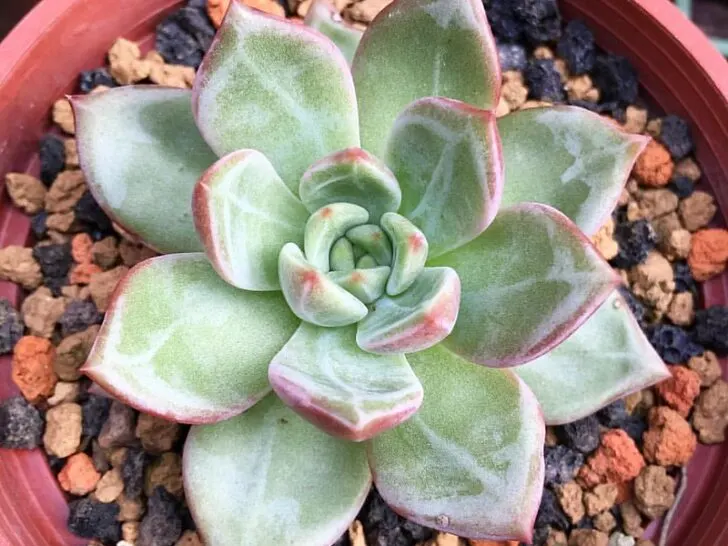
The Echeveria pink champagne is a Korean hybrid. It can be green, creamy white, blue, purple, pastel pink, or red. Like the Echeveria laui in its parentage, the pink champagne needs stress to retain a solid pink color.
The pink champagne is rose-shaped with upwards-facing leaves, similar to a lotus flower. Each leaf is a thin teardrop shape. Usually, leaves are green near the base and colorful near the tip.
Different stress levels create different color levels. Unstressed plants will be mostly green. Slightly stressed plants will be green with highlights. Highly stressed plants will be solid pink, purple, or red.
Like its parent, the echeveria laui, you can safely stress pink champagnes with drought. You can also try cooling them down without freezing them. Cool temperatures cause stress, but temperatures below 50°F (10°C) can cause damage. Cool them to a temperature below 65 (18°C) and above 50 (10°C).
13. Pink Frills (Echeveria shaviana)

The Echeveria shaviana also has multiple nicknames, like ‘pink frills’ or ‘Mexican hens and chicks.’ It’s a cabbage-shaped succulent with upward-facing leaves that have curly pink edges. New leaves grow in the center, start light purple, and turn silvery-blue with age.
Pink frills vary in size based on their container. In a large pot, this plant can grow up to 1 foot (30 cm) in height and 7 inches (18 cm) in width. Their adaptive size makes them versatile decorations for small centerpieces or large planters.
Color vibrancy depends on sunlight and works on a ‘leaf-by-leaf’ basis. If one side of the plant gets more sun than the other, the plant will have one brighter half and one duller half. Try rotating its pot every few hours to keep its color even, or place it under a lamp.
14. Molded Wax (Echeveria taurus)
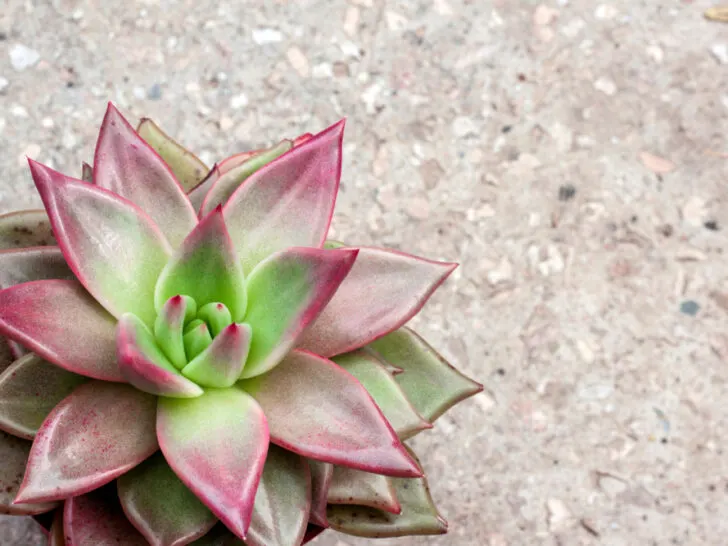
The echeveria Taurus is a rose-shaped succulent with upward-facing teardrop-shaped leaves. It’s also nicknamed ‘molded wax,’ possibly because of the slight indent on each leaf. This plant typically has multicolored leaves that range from blush pink to wine red.
Molded wax plants can be incredibly colorful. New leaves are bright green, giving these pink or red plants vibrant green centers. They may also sprout blue, yellow, or orangey-red flowers during the summer. The molded wax plant is evergreen, so it stays colorful all year round.
The teardrop shape of each leaf ends with a sharp point. This shape gives the leaves a more triangular look, but each tip can be sharp to the touch. Be careful when you handle your plant. Like most succulents, echeveria Taurus prefers bright direct sunlight and low water.
15. Blue Beans (Graptopetalum pachyphyllum)

Graptopetalum pachyphyllum, also known as ‘blue beans’ or the ‘ghost flower succulent,’ is a small rosette with bulbous leaves. These leaves change color depending on their environment. They can be pink, green, silver-grey, lavender, or blue.
Blue beans are low maintenance unless you’re particular about their color. With regular care, they will most likely turn bluish-green or greyish-purple. They become pink when exposed to extra sunlight or cooler temperatures.
Encourage them to turn pink by dropping their usual temperature by about 50°F (10°C) at night. Make sure you raise the temperature again during the day to prevent damage. Alternatively, you can try increasing their sunlight exposure to 8-12 hours per day.
Blue and green blue beans have reddish-pink tips. So, even if you prefer low-maintenance care, they still have pink accents. Their compact size makes them great for desks and offices.
16. Ghost Plant (Graptopetalum paraguayense)
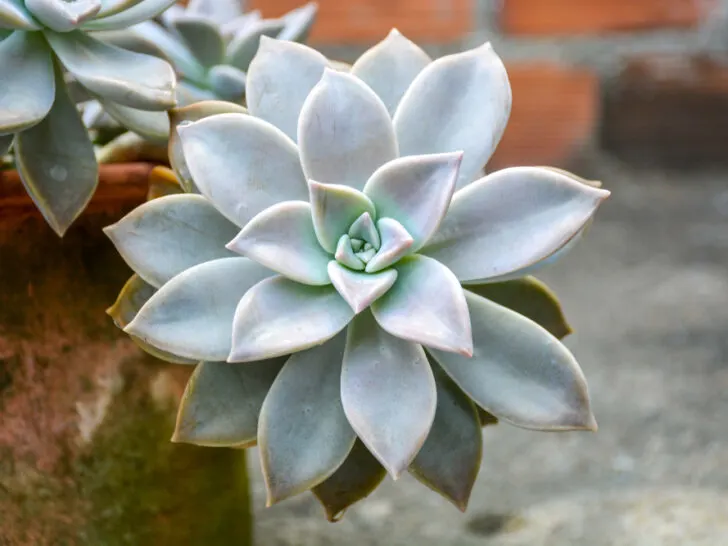
The Graptopetalum paraguayense has nicknames like the ‘ghost plant,’ ‘ghostie,’ or ‘mother of pearl plant.’ It’s lotus-like in appearance with upwards-facing petal-shaped leaves in a compact rosette. Its color varies with temperature and humidity.
Ghosties turn yellowish-pink in warm, dry environments with full sunlight. They turn light grey or powder blue in cooler, humid environments with partial shade. Like PVNs, ghost plants are covered in pruinose, so they have a frosted appearance.
Typically, blue or grey ghosties have a light pink tinge. So, if you want a succulent that is pinkish but not too pink, these plants might be a good option. Ghost plants are also mildly cold-resistant, so they can do well in outdoor planters.
Interestingly, many ghost plants have edible leaves. However, they should only be consumed in small quantities. Originally, ghost plants were ornamental plants. Later, the Japanese selectively bred them to be edible.
If you want to taste your ghost plant, buy an edible specimen. Not every ghostie comes from the edible Japanese lineage.
17. Debbie (Graptoveria)
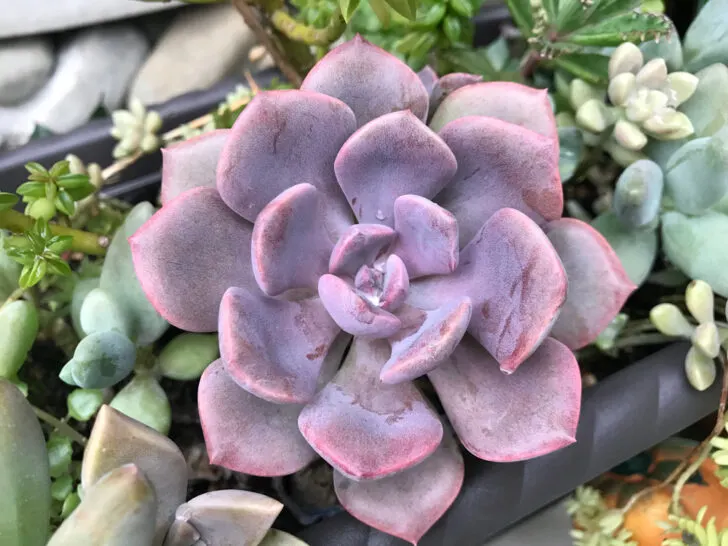
Graptoveria ‘Debbie,’ or ‘Debbi,’ is an Echeveria-graptopetalum hybrid with pale purple leaves that turn pink under stress. Without stress, it’s bluer. Like both its parents, it’s a compact rosette. Like most graptopetalums, it has rounded petal-shaped leaves.
Debbies are relatively beginner-friendly if you’re not picky about keeping them pink. They can handle full or partial sunlight. However, the more sunlight they get, the brighter their color. Like their echeveria parents, Debbies do well with ‘soak and dry’ watering.
Unlike many of their relatives, Debbies are dormant in the summer and active in the winter. As a result, you’ll get a brighter-colored plant during the cooler seasons. Despite its summer dormancy, it’s not cold-tolerant. Therefore, Debbies should stay indoors when it’s cold out.
Debbies also have a frosty appearance from a pruinose layer.
18. Graptoveria douglas huth

‘Douglas Huth’ is an echeveria-graptopetalum hybrid. It has a lotus-like appearance with long petal-shaped leaves. Its color depends on its sunlight exposure. Douglas huth leaves have a greyish-green base that tints pink in full sunlight or blue in partial sunlight.
No succulent can handle the harsh cold, but this plant has a higher-than-average cold tolerance. It can tolerate temperatures as low as 21°F (-6°C), making it a good choice for people in cooler regions.
Even if your Douglas huth is blue from partial sunlight, it will still grow creamy pink flowers each spring at reproductive maturity. Therefore, you don’t necessarily need to give it full sunlight to get a pink decorative plant.
19. Mother of Thousands (Kalanchoe daigremontiana)

The Kalanchoe daigremontiana ‘mother of thousands’ is also known as the ‘pink sparkler’ or the ‘pink butterfly.’ It has a 24-36 inch (61-91 cm) stem with several tree-like branches. Each branch ends in a bright green spear-shaped leaf. These leaves have tiny pink florets outlining them.
Mother of Thousands are fairly beginner-friendly. However, you need to be careful about their sunlight exposure. The thinner leaves and tiny florets are rather delicate and especially prone to scorching. Don’t water them until their soil is completely dry.
Mother of Thousands will drop florets, but these florets cannot propagate. If you want to propagate your plant, stem cuttings are the best option. Their florets are very fragile and will fall off the leaf when you touch them. If this happens, it doesn’t mean your plant is unhealthy.
These succulents are also toxic to cats and dogs. Therefore, they may not be a good choice for pet owners. If you decide to get one anyway, please supervise your furry friends around your kalanchoe or place it out of reach. Be extra careful about escape florets.
20. Pink Ice Plant (Oscularia deltoides)
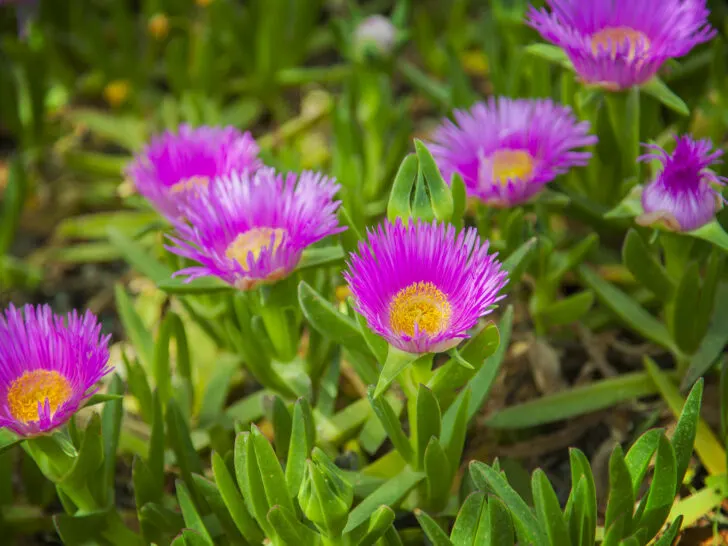
Oscularia deltoides are commonly called the ‘pink ice plant,’ ‘deltoid-leaved dew plant,’ or the ‘tooth-leaf rock vygie.’ It has small, pale green pyramid-shaped leaves outlined in pink cactus-like spikes that are soft to the touch. They also have pink or purple flowers.
Pink ice plants are very resilient, making them great for beginner gardeners. They don’t need much water and are incredibly cold-tolerant for a succulent. The pink ice plant can handle temperatures as low as 15°F (-9°C), so they can stay outside for a long time.
These plants are most active during spring and summer, which is when they will sprout their flowers. During this time, weekly watering is sufficient. The more water you give them, the plumper their leaves become. So, water them more frequently to encourage this look.
During winter, you can forgo watering them for the entire season because they go into hibernation. They survive during winters off the water they stored in their leaves earlier in the year.
21. Pink Moonstone (Pachyphytum oviferum)
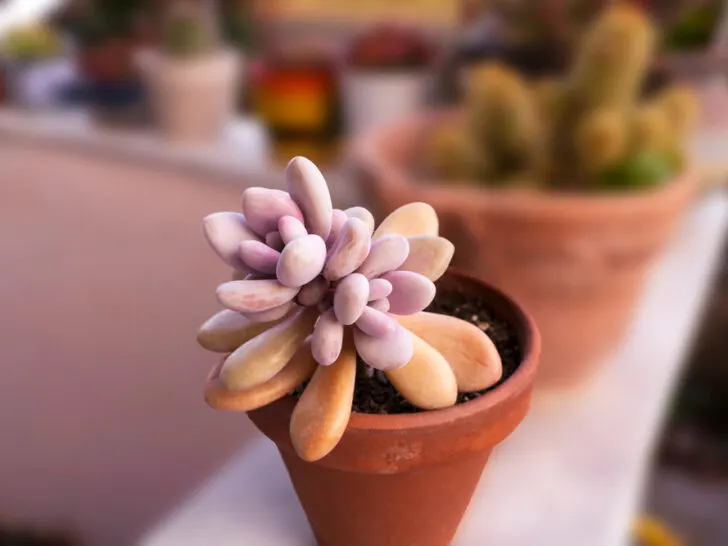
Pachyphytum oviferum, or ‘pink moonstone,’ is a small succulent with puffy egg-shaped leaves. Its leaves grow in compact clusters that give it a floral appearance. Colors range between pastel pink, peach, light orange, and lavender.
Since these pink succulents only grow to approximately 5-8 inches (13-20 cm), they’re perfect for small pots, desk ornaments, and arrangements. However, ensure they get at least 4-6 hours of sunlight per day to stay healthy.
Pink moonstones can store a lot of water in their chubby little leaves. Therefore, you don’t need to water them often. Use the ‘soak and dry’ method or look at their leaves to gauge their thirst. When pink moonstones are thirsty, their leaves will ‘deflate’ or look wrinkly.
These pink succulents also have a frosty appearance from pruinose.
22. Jelly Bean (Sedum rubrotinctum)
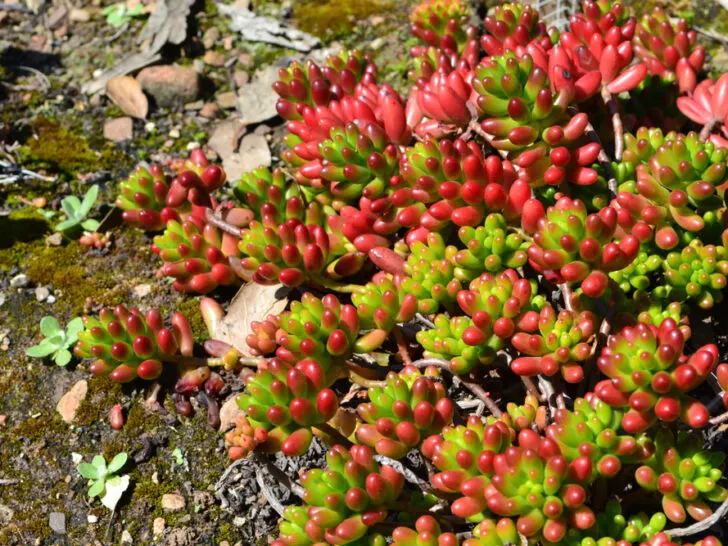
Sedum rubrotinctum is also known as the ‘jelly bean plant,’ ‘pork and beans plant,’ or ‘Christmas cheer.’ It grows thin brown stems that end in clusters of small, thick bean-shaped leaves. Leaves are green with red or pink tips but may turn brown with heat.
Jelly beans can survive in various light conditions. However, sun exposure and temperature change their color. Plants in partial shade and warm climates are green with pink or red tips. In direct sunlight and high heat, they turn brown.
Brown jelly beans aren’t necessarily unhealthy or dehydrated. Nevertheless, you should keep an eye on them to make sure they don’t scorch or dehydrate in intense heat. Scorched beans will have spots, and dehydrated beans will shrivel.
Be aware that these plants are toxic to cats, dogs, and humans. So, they may not be a good choice for pet owners or parents with young children. You should also wear gloves while handling them because their leaves can cause skin irritation.
Conclusion
If you want pink succulents in your collection, you have a lot of choices. Succulents come in many shades of pink, lots of shapes, and lots of sizes. Some plants need extra work if you want them to stay pink, but there are plenty of beginner-friendly options too.
Other Articles You May Also Be Interested In
31 Pretty Succulents That Flower

